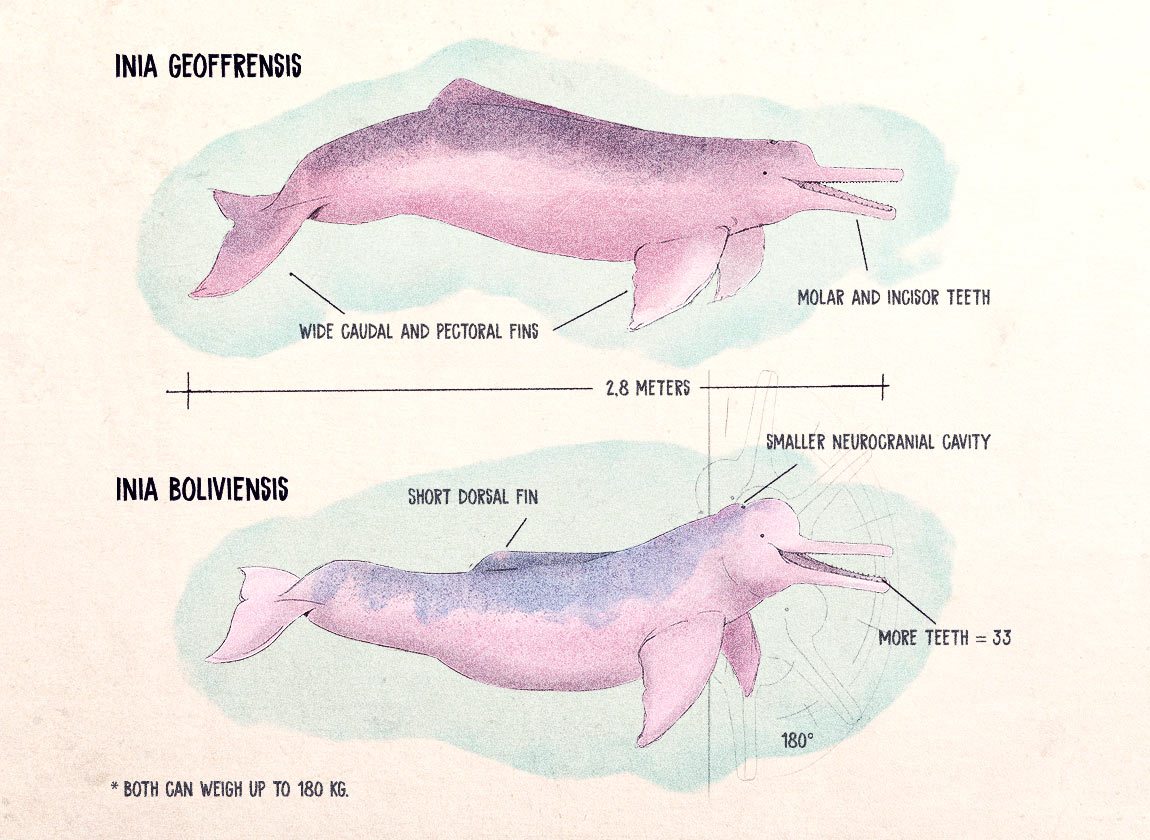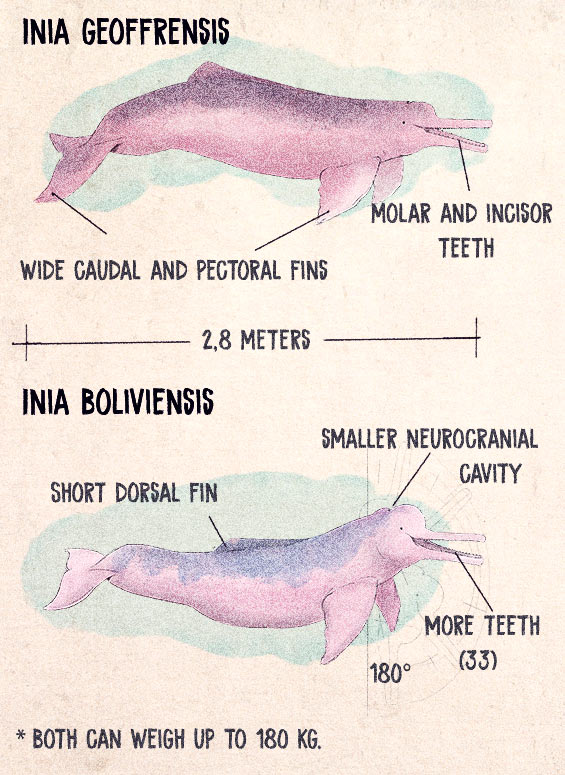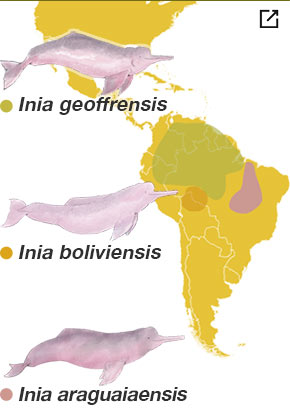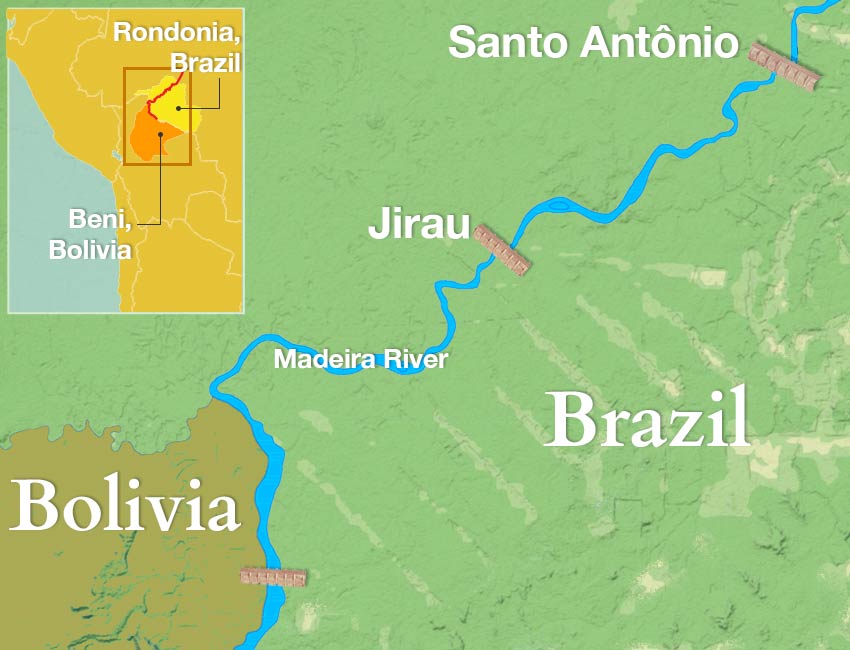Jirau and Santo Antonio hydroelectric plants on the largest affluent of the Amazon River have become an evolutionary experiment in real time, isolating a population of dolphins from Bolivia and Brazil.

They are the lords of the river, pink and resplendent as they glide through the turbid waters of the upper reaches of the Madeira River. For as long as anyone can remember this mighty tributary, the largest of the Amazon River, has been their home.
In the past, the mythological aura that has surrounded these dolphins has allowed them to gain a sort of respect in the riverside communities inhabited by indigenous people and local fishermen in different parts of the Bolivian Amazon. And in a way, this has saved them from indiscriminate hunting.
Several of these legends show the bufeo (Inia boliviensis) as a 'seducer' that conquers the women of the villages, who once under their spell, want to spend all their time by the river until they end up throwing themselves into the water to be at the side of their beloved bufeo.
Their unique characteristics -- a larger number of teeth, a smaller skull and a body of solid appearance -- have distinguished them from other freshwater dolphins. But it is their color, a light pink tone that shimmers in the sun, that makes these dolphins venerated.



The distinction with its closest relative - I. geoffrensis - is the result of natural barriers, waterfalls and rapids, which thousands of years ago isolated part of the population. While I. geoffrensis is found in Venezuela, Colombia, Peru, Brazil and Ecuador, the I. boliviensis, as its name indicates, is only present in Bolivia.

But according to recent studies, this natural isolation has never been a definitive prison. The bufeos can make regional migrations and visit their closest relatives living under the rapids of the Madeira River. When they meet, the two dolphins can even mate, allowing a hybridization of the species.
But the construction of the Jirau and Santo Antônio hydroelectric dams about a decade ago in the Madeira River basin isolated Inia boliviensis from its relative Inia geoffrensis, resulting in a population of dolphins trapped between the two large dams.

Located in the state of Rondonia, Brazil, a few hundred kilometers from the department of Beni, Bolivia, the Santo Antônio and Jirau dams began operating in 2012 and 2013 respectively. Together they have a capacity of more than 7,300 MW, which makes them two of the largest ever built in South America and the largest ever implemented on a western Amazon river, which has its origin in the Andes.
Its beginnings date back a little more than a decade, when in 2008, the government of then Brazilian President Luís Inácio Lula da Silva, who belonged to the Workers' Party (PT), granted private businessmen the right to build two large hydroelectric dams on the Madeira River.
The technical advisors of the Brazilian environmental agency, IBAMA, even discouraged the construction of the hydroelectric plants, due to the impact on migratory fish species, particularly large catfish. But the Lula government itself ignored the analyses of its technicians and proceeded with the construction.
As a mitigation measure, both plants implemented fish transposition systems. In theory, this would ensure that migratory species could continue to transit the waters of the Madeira River. However, neither of these systems was designed to ease the flow of aquatic mammals such as bufeos.
This was pointed out in an article published in January 2014 in the academic journal Conservation Genetics, in which researchers from the Federal University of Amazonas and the National Institute of Amazonian Research (INPA) stated that, "two dams have recently been built in the rapids region; neither has a mechanism to maintain connectivity between upstream and downstream regions, and together with anthropogenic changes in the hydrodynamic regime and fluvial ecology are likely to have serious long-term and short-term consequences for I. boliviensis and other aquatic species.”
The serious consequences that scientists from the Federal University of Amazonas and INPA warned about were also pointed out by researchers from the Mamirauá Institute and WWF Brazil after reviewing IBAMA's opinions and technical notes during and after the environmental licensing of the two dams.
These researchers revealed that there is now a population of approximately 50 to 100 bufeos trapped between Jirau and Santo Antônio.
Initially, when the geographic distributions of Inia boliviensis and Inia geoffrensis were not well known, the Jirau dam indicated that the construction would facilitate even more intense contact between the two species, something that would occur with the flooding of the natural barriers that separated them, for example the waterfalls and rapids. In other words, the millennial isolation of Inia boliviensis would be ended by force.
The genetic studies performed throughout 2012 by the Jirau construction company demonstrated that even before the closure of the floodgates, individuals of the species Inia boliviensis were observed upstream and downstream of five large waterfalls, which seemed to indicate that the dam did not represent insurmountable barriers. At the time, it seemed that no mitigation measures were necessary.
However, a 2018 technical report prepared by Jirau's own concessionaire, Energia Sustentável do Brasil (ESBR), confirmed that the dam promoted the isolation of the Inia boliviensis populations upstream. And for the first time, it was pointed out that, "ESBR is requested to include in the executive project of wildlife conservation to be presented to IBAMA, environmental compensation actions related to this population of cetaceans isolated between the two dams.”
What happens when a population of river dolphins gets trapped between dams?
We asked biologist Miriam Marmontel, one of the main researchers on cetaceans in Brazil at the Mamirauá Institute. She said very little is known about the situation of these bufeos, but that this type of confinement represents a genetic impoverishment that eventually condemns them to disappear. "They are relatively few of these animals and the tendency is for them to get sick. We don't know how long it will take.”

Despite several technical notes from IBAMA calling for the constant monitoring of the populations of bufeos trapped by the hydroelectric plants, researchers say there is no real monitoring effort by the companies.
The companies minimized the impacts. In the case of Santo Antônio Energia, they responded to our request for information by indicating that previous analyses showed populations only upstream of the plant, and not between the two dams, which, according to them, would not prevent the dolphins from reproducing.
The company responded through its press office that:
"Santo Antônio Energia is analyzing the possibility of carrying out a population monitoring or genetic analysis of these species to find out if the number of individuals remains constant and if there is viability of reproduction among them. The monitoring of the species depends on the authorization of IBAMA.”
In the case of the ESBR consortium, owner of the Jirau plant, the response sent by their press office minimized the importance of what they themselves stated in 2018. The company stressed that so far, its monitoring has not indicated any problem affecting the dolphins.
"[The Company] has been complying with the requirements of the environmental license, with the renewal of its license granted in 2019 by IBAMA for ten additional years. The actions indicated in the license were properly fulfilled, so dozens of monitoring campaigns were carried out in the Area of Direct Influence, verifying the existence of only one species of boto, Inia boliviensis, the only species present in this section of the Madeira River.”